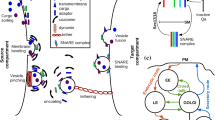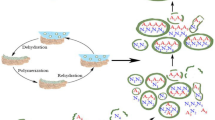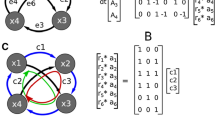Abstract
The question “What was the minimum number of genes necessary in the early cell” is rephrased as “Is it feasible to assume that early cells had no genes?” It is shown that a kind of primitive life process could exist on the basis only of properties specific to vesicles, and that it would have the potential to evolve into more complex cell-like processes.
Similar content being viewed by others
Avoid common mistakes on your manuscript.
Life on Earth is based on cells whose essence is that they are individual, structured entities that occupy a certain volume of space and are able to grow and reproduce, and to evolve by adapting to environmental change. The question arises as to what is the simplest form of cell exhibiting this behavior. One possible measure of cell simplicity is the minimum number of genes necessary for its operation. However, there are features found in the living cell that are exhibited by systems with no genes. Accordingly, a lipid world scenario has been suggested as an early evolutionary step in the emergence of cellular life, on grounds of the possible abundance of lipids and other amphiphilic molecules in the prebiotic environment, their capacity to aggregate spontaneously into micelles or vesicles and thus compartmentalize the space, and the ability of amphiphilic assemblies to transmit compositional information (Segré et al. 2001). This idea was corroborated by the observation that growing vesicles exhibit the phenomenon of vesicle fission and thus self-reproduce because the siblings, by inheriting the same internal solution and the same membrane, retain the properties of the parent vesicle (Berclaz et al. 2001).
It is tempting to propose that the complex life processes of today are an upgraded version of a kind of primitive life process that could have existed based on simple vesicles. Vesicles are defined as entities in which a thin flexible membrane separates their internal aqueous solution from the external aqueous environment. Their behavior is governed by simple laws of physics and chemistry. The question remains how, on the basis of these laws, vesicles could have evolved into the complex and organized structures of contemporary cellular systems. Here we introduce the concept of a vesicle world, by drawing attention to the possible role of vesicle shape behavior. This vesicle property pertains to the vesicle as a whole and does not depend essentially on the composition of its membrane, just as there are many properties of molecules which are characteristic of molecules and not of the atoms from which they are made. The shape behavior of vesicles is independent of whether their membranes are of lipid origin or formed from other molecules such as surfactants and polymers.
Vesicle shape behavior has been studied comprehensively, both theoretically and experimentally (reviewed in Seifert 1997; Svetina and Žekš 2002). One important parameter that characterizes vesicle shape is the vesicle volume relative to the volume of the sphere with the same membrane area. The smaller this relative volume, the more flaccid is the vesicle. Shapes of flaccid vesicles are determined by the minimum of their membrane bending energy. The latter depends on the membrane asymmetry measured, for instance, by membrane spontaneous curvature (Helfrich 1973). Continuous variation of spontaneous curvature causes continuous change of vesicle shape of a given symmetry, while a discontinuous shape transformation may also occur into a vesicle shape having other symmetry. Vesicle shape transformations often terminate in a budded shape, i.e. a shape composed of several spheres connected by thin necks, where the radii of these spheres may have only two different values (Svetina and Žekš 1989).
It is plausible to assume that vesicle self-reproduction occurs when budded shape is composed of two spheres connected by a single neck by breaking of this neck. A prerequisite for this to happen is that, during its growth, the shape of a vesicle transforms from an initial sphere to a final budded shape composed of two spheres. Thus the processes of vesicle self-reproduction and vesicle shape transformations are interconnected. We recently revealed consequences of this interconnection by a theoretical analysis of the self-reproduction behavior of a vesicle whose features were described by the minimum number of necessary macroscopic parameters (Božič and Svetina 2004). Vesicles were assumed to grow due to the incorporation of new membrane material, with the growth rate defined as the doubling time of the membrane area (T d). Vesicle volume changed due to membrane permeability for solvent (measured by the hydraulic permeability L p) and to the membrane elastic energy that gives rise to the pressure difference between the outside and inside of the vesicle. Vesicle size was determined by membrane spontaneous curvature (C 0). To attain, within the time period T d, the shape transformation from sphere to a shape composed of two spheres connected by a thin neck, each of them of the size of the initial vesicle, the membrane bending constant (k c) had to be such that the product of the four model parameters T d L p k c C 0 4 assumed a fixed value, found by numerical analysis to be 1.85. For parameters giving a smaller value than this, a vesicle would continue to grow into a membranous conglomerate with no special shape characteristics. For parameters giving a larger value, a vesicle would eventually reach a shape composed of two spherical parts of different radii, also connected by a thin neck. In the latter case the average doubling time of the number of vesicles was shown to be larger than the doubling time of the membrane area.
In the prebiotic environment many different monomeric molecules, or their complexes, could have been incorporated into the existing vesicle membranes, and it is possible that many different membrane compositions existed that could give rise to the process of self-reproduction. The obtained condition for vesicle self-reproduction relates vesicle intrinsic properties (parameters depending on membrane composition) to the external conditions (parameters defining the doubling time). It can therefore be viewed as a selectivity criterion for the competition between vesicles with different membrane compositions. The selectivity principle is imposed in the sense that vesicles that satisfy the obtained criterion increase their number faster than other vesicles. Vesicles with the shortest vesicle number doubling time will outnumber any other vesicles. Thus, the performance of the system whose parameters give a value of the obtained condition larger than 1.85 can be improved by the variation of vesicle parameters in a direction approaching this value. Having reached this value, the system can still improve its growth efficiency by a decrease of membrane area doubling time and the corresponding increase of one or more other parameters.
It has been postulated that life originated from an as yet unknown elementary autocatalyst that occurred spontaneously, then replicated autocatalytically and eventually acquired the capacity to adapt to the environment (Lifson 1997). Vesicles appear to be an appropriate candidate for such an elementary autocatalyst because, as demonstrated, it is possible to ascribe to them the principle of natural selection. In scenarios for the emergence of life, the order in which different life characteristics came into existence, or alternatively, how various sets of chemical compounds carrying different characteristics merged into a common unit are matters of discussion. Vesicles themselves carry many essential characteristics, which suggests the possibility of a single evolutionary pathway from simple vesicles to complex ones that eventually acquire the properties of contemporary cells. We shall proceed by presenting some speculations about possible effects that a system of exponentially growing vesicles can exert on the environmental chemistry, and about possible mechanisms for increasing system complexity.
Under conditions of different external energy sources the prebiotic chemical environment must have been governed by the formation and degradation of molecules with energies that are higher than the sum of the energies of the molecules from which they were synthesized. It is reasonable to assume that, during certain, possibly long periods of time, stationary conditions were established giving rise to certain relative abundance of different intermediate molecules depending on the corresponding rates of synthesis and degradation. The exponentially increasing number of vesicles with selected composition of their membranes constitutes a sink of corresponding molecules. A natural consequence of this is that the degradation pathways containing the precursors of these molecules are shifted in the direction that favors their replenishment. The effect can be understood as a modification of naturally occurring degradation pathways and thus as the establishment of a kind of rudimentary metabolism.
It can be envisaged how vesicles can increase their complexity, i.e., that, in addition to the function of self-reproduction, they acquire other cell-like functions, for instance that they take over the synthesis of some of their constituents. Having available large areas of vesicle surface, the probability increases that these surfaces begin to serve as substrates for catalyzing the environmental chemical reactions. If these reactions involve the synthesis of different membrane constituents, the system would tend to improve its performance because the concentration of membrane constituents near the surface becomes larger, which could increase the rate of membrane area growth, with consequent decrease of the doubling time. It can be assumed that the number of localized catalytic reactions needed for synthesis of vesicle components increases step by step. Another possibility is that vesicles become more complex by the fusion of two vesicles carrying different additional functions. Such a fusion would produce a new vesicle that would inherit both characteristics, leading to a faster multiplication than those of its ‘parents’. Eventually, a large number of metabolic reaction steps would accumulate in a single vesicle.
In conclusion, the vesicle world involves several characteristics of cellular life which implies that a primitive life could have existed in the absence of specific genetic material. Subsequent evolution would be possible, based on the laws of physics and chemistry, of a simple vesicle system into a complex one.
References
Berclaz N, Müller M, Walde P, Luisi PL (2001) Growth and transformation of vesicles studied by ferritin labeling and cryotransmission electron microscopy. J Phys Chem B 107:1056–1064
Božič B, Svetina S (2004) A relationship between membrane properties forms the basis of a selectivity mechanism for vesicle self-reproduction. Eur Biophys J 33:565–571
Helfrich W (1973) Elastic properties of lipid bilayers: theory and possible experiments. Z Naturforsch C 28:693–703
Lifson S (1997) On the crucial stages in the origin of animate matter. J Mol Evol 44:1–8
Segré D, Ben-Eli D, Deamer DW, Lancet D (2001) The lipid world. Orig Life Evol Biosph 31:119–145
Seifert U (1997) Configurations of fluid membranes and vesicles. Adv Phys 46:13–137
Svetina S, Žekš B (1989) Membrane bending energy and shape determination of phospholipid vesicles and red blood cells. Eur Biophys J 17:101–111
Svetina S, Žekš B (2002) Shape behavior of lipid vesicles and the basis of some cellular processes. Anat Rec 268:215–225
Acknowledgments
This work was supported by Slovenian Research Agency through Grant P1-0055 and benefited from the COST Chemical Action D27.
Author information
Authors and Affiliations
Corresponding author
Rights and permissions
About this article
Cite this article
Svetina, S. Question 7: The Vesicle World: The Emergence of Cellular Life can be Related to Properties Specific to Vesicles. Orig Life Evol Biosph 37, 445–448 (2007). https://doi.org/10.1007/s11084-007-9087-0
Received:
Accepted:
Published:
Issue Date:
DOI: https://doi.org/10.1007/s11084-007-9087-0




